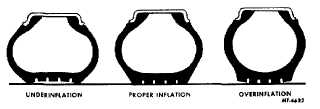|
| |
TM 5-4210-230-14&P-1
VEHICLE MAINTENANCE
TIRE INFLATION
Inflation pressures should be checked when tires are cool, using an accurate tire pressure .gauge. Check pressures at regular
intervals.
CAUTION
Bleeding the air from hot tires is dangerous and should not be attempted. While the pressure will be reduced, an
increase in temperature of the tire will take place as soon as driving is resumed and tire failure will occur. Tire failure
could result in bodily harm or property damage in the event of an accident.
UNDERINFLATION
Too little air pressure increases deflection, causes the tread to wipe and scuff over the road, results in extra strain on the tire, and
increases the changes for bruising.
PROPER INFLATION
Maintaining the proper air pressure provides maximum road contact and results in increased tire life.
OVERINFLATION
Overinflation reduces tire deflection and tire contact area, causing the tire to ride on the crown, and results in rapid wear in the
center of the tread.
CAUTION
Tires used on multipiece rims should be assembled and inflated only by experienced personnel. Bodily injury may be incurred
with improper assembly or inflation techniques.
TIRE MATCHING
DUAL TIRES
Use care in matching dual tires. Tires which differ more than 6.4mm (¼ in.) in diameter or 19.1 mm (¾ in.) in circumference
should not be mounted on the same dual wheel. Should it become necessary to mount two tires of unequal size on the same dual
wheel, place the larger or less worn tire on the outside.
DRIVE AXLES
Tires of the same size and specifications must be installed on both front and rear driving axles of the vehicle. If different size
tires are used when vehicle is operated with both the front and rear axles engaged, a torque build-up between the axles, caused by
the different diameter tires, will result in excessive tire wear and strain on the entire drive unit. This method of tire mounting will also
cause high axle lubricant temperatures which may lead to premature axle failure.
TIRE MIXING
RADIAL AND BIAS PLY TIRES
It is recommended that for best overall performance that only bias or only radial tires be used on a vehicle. However, different
heavy truck tires may be used per the following:
Bias or radial tires may be used on either axle of two-axle vehicles if the vehicle has dual rear wheels, or is equipped with
wide base single tires.
Either bias or radial tires may be used on the steering axle of vehicles with three or more axles.
Never mix different tire sizes or constructions on the same axle.
Never mix bias and radial tires in a tandem drive axle combination.
TIRE ROTATION
ROTATION IS ALWAYS ADVISABLE:
1.
If front (steering) axle tires become irregularly worn, move to rear or trailer position.
2.
In a dual assembly, if one tire wears much faster than its mate, reverse position of tires.
ROTATION MAY BE ADVISABLE:
1.
If rib-type tires are used in all wheel positions: FRONT (STEERING) AXLE-Install new tires in front wheel positions. When
worn to no less than 3.175 mm (1/8 in.) remaining groove depth, move to any other position. REAR AND TRAILER AXLES
Tires must be removed when worn to no less than 1.588 mm (1/16 in.) remaining original groove depth. However, tires
identified by the word "regroovable" molded on the side wall can be regrooved.
12
|

